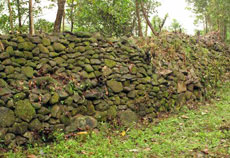Truong Luy dubbed “Vietnam’s Great Wall†in Quang Ngai was recognized as a national heritage site by the Ministry of Culture, Sports and Tourism in order to help promote its historical significance.

Truong Luy, which means long rampart, was built in the 17th century for military purposes. It is 127km long, 2m high and 1m wide.
It covers eight districts (Tra Bong, Son Tinh, Son Ha, Tu Nghia, Minh Long, Nghia Hanh, Ba To and Duc Pho) of the central province of Quang Ngai and two districts (Hoai Nhon and An Lao) of the neighboring province of Binh Dinh, along the Truong Son mountain range.
The wall has been compared to Hadrian’s Wall which was constructed in AD122 to stop Scottish invaders coming into England on the edge of the Roman Empire.
Many sections of Truong Luy are made of stone with others a combination of earth and stone. It includes fortifications, roads and military posts.
Despite the passing of time, many sections of the wall remain in their original state.
A recent workshop on the historical significance of the wall was held in Quang Ngai Province with the participation of domestic and foreign researchers from the Vietnam Archaeology Institute and the L’Ecole Francaise d’Extreme Orient (the Far East Archaeological Research Institute).
“Truong Luy presents an enormous opportunity for research, careful conservation and sustainable use,†Professor Christopher Young, head of International Advice at English Heritage said at the workshop.